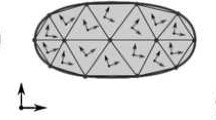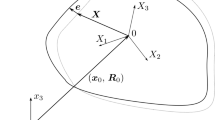Abstract
The introduction of moving loads in the Floating Frame of Reference Formulation is presented. We derive the kinematics and governing equations of motion of a general flexible multibody system and their extension to moving loads. The equivalence of convective effects with Coriolis and centripetal forces is shown. These effects are measured numerically and their significance in moving loads traveling at high speed is confirmed. A method is presented to handle discontinuities when moving loads separate from the flexible structure. The method is extended from beam models to general flexible structures obtained by means of the Finite Element Method. An interpolation method for the deformation field of the modal representation of these bodies is introduced.
The work is concluded by application of the method to modern mechanical problems in numerical simulations.













Similar content being viewed by others
References
Arnold, M., Heckmann, A.: From multibody dynamics to multidisciplinary applications. In: García Orden, J., Goicolea, J., Cuadrado, J. (eds.) Multibody Dynamics, Computational Methods in Applied Sciences, vol. 4, pp. 273–294. Springer, The Netherlands (2007). doi:10.1007/978-1-4020-5684-0_13
Arnold, M., Simeon, B.: Pantograph and catenary dynamics: a benchmark problem and its numerical solution. Appl. Numer. Math. 34(4), 345–362 (2000)
Bajer, C., Dyniewicz, B.: Numerical Analysis of Vibrations of Structures Under Moving Inertial Load. Lecture Notes in Applied and Computational Mechanics, vol. 65. Springer, Berlin (2012)
Bremer, H.: Elastic Multibody Dynamics. Springer, Berlin (2008)
Buchau, O.: Flexible Multibody Dynamics. Solid Mechanics and Its Applications, vol. 176. Springer, The Netherlands (2011)
Dietz, S., Hippmann, G., Schupp, G.: Interaction of vehicles and flexible tracks by co-simulation of multibody vehicle systems and finite element track models. In: 17th Symposium Dynamics of Vehicles on Roads and Tracks, IAVSD 2001, Copenhagen (2001)
EN 50318: Railway applications—current collection systems. Validation of simulation of the dynamic interaction between pantograph and overhead contact line (2002)
Fasshauer, G.E.: Meshfree Approximation Methods with Matlab, vol. 6. World Scientific, Singapore (2007)
Fryba, L.: Vibration of Solids and Structures Under Moving Loads. Noordhoff, Groningen (1972)
Frỳba, L.: Estimation of fatigue life of railway bridges under traffic loads. J. Sound Vib. 70(4), 527–541 (1980)
Hartweg, S., Heckmann, A.: Modeling of flexible multibody systems excited by moving loads with application to a robotic portal system. In: The Second Joint International Conference on Multibody System Dynamics (IMSD), Stuttgart, Germany (2012)
Heckmann, A., Otter, M., Dietz, S., López, J.D.: The DLR FlexibleBody library to model large motions of beams and of flexible bodies exported from finite element programs. In: 5th International Modelica Conference, pp. 85–95 (2006)
Johansson, C., Pacoste, C., Karoumi, R.: Closed-form solution for the mode superposition analysis of the vibration in multi-span beam bridges caused by concentrated moving loads. Comput. Struct. 119, 85–94 (2013)
Kaiser, I.: Refining the modelling of vehicle–track interaction. Veh. Syst. Dyn. 50(1), 229–243 (2012)
Michaltsos, G., Kounadis, A.: The effects of centripetal and Coriolis forces on the dynamic response of light bridges under moving loads. J. Vib. Control 7, 315–326 (2001)
Olsson, M.: On the fundamental moving load problem. J. Sound Vib. 145, 299–307 (1991)
Ouyang, H.: Moving-load dynamic problems: a tutorial (with a brief overview). Mech. Syst. Signal Process. 25, 2039–2060 (2010)
Poetsch, G., Evans, J., Meisinger, R., Kortüm, W., Baldauf, W., Veitl, A., Wallascheck, J.: Pantograph/catenary dynamics and control. Veh. Syst. Dyn. 28(2–3), 159–195 (1997)
Shabana, A.: Dynamics of Multibody Systems, 2nd edn. Cambridge University Press, Cambridge (1998)
Simeon, B.: Computational Flexible Multibody Dynamics. A Differential-Algebraic Approach. Differential-Algebraic Equations Forum. Springer, Berlin (2013)
Stanišić, M.M., Euler, J.A., Montgomery, S.T.: On a theory concerning the dynamical behavior of structures carrying moving masses. Ing.-Arch. 43, 295–305 (1974)
Tau, J.D.: Vibration control of maglev vehicles traveling over a flexible guideway. J. Sound Vib. 321, 184–200 (2009)
Veitl, A., Arnold, M.: Coupled simulation of multibody systems and elastic structures. In: Ambrósio, J., Schiehlen, W. (eds.) Advances in Computational Multibody Dynamics, pp. 635–644. IDMEC/IST Lisbon, Portugal (1999)
Veitl, A., Kortüm, W.: Simulation and control design for mechatronic pantographs. In: Supplement to Vehicle System Dynamics, vol. 33, pp. 431–441. Swets en Zeitlinger, Lisse (1999)
Wallrapp, O.: Standardization of flexible body modeling in multibody system codes, part 1: definition of standard input data. Mech. Struct. Mach. 22(3), 283–304 (1994)
Acknowledgements
We would like to thank Martin Otter, Institute of System Dynamics and Control at the DLR, for his help concerning the interpolation method used to retrieve global mode shapes.
Author information
Authors and Affiliations
Corresponding author
Rights and permissions
About this article
Cite this article
Hartweg, S., Heckmann, A. Moving loads on flexible structures presented in the floating frame of reference formulation. Multibody Syst Dyn 37, 195–210 (2016). https://doi.org/10.1007/s11044-016-9512-0
Received:
Accepted:
Published:
Issue Date:
DOI: https://doi.org/10.1007/s11044-016-9512-0




